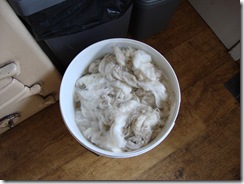 Geraldine’s fleece has been soaking in a large bucket of soft water for a few days, which was changed daily to loosen dirt etc – this process is very suited to ancient breeds like the Shetland, something to do with how much lanolin is in fleece but in any case it really makes the eventual wash much easier.
Geraldine’s fleece has been soaking in a large bucket of soft water for a few days, which was changed daily to loosen dirt etc – this process is very suited to ancient breeds like the Shetland, something to do with how much lanolin is in fleece but in any case it really makes the eventual wash much easier.
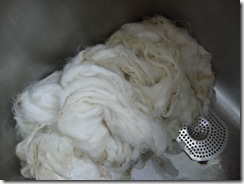 Several very hot washes with no agitation but plenty of soap later, thank goodness I have a large deep sink.
Several very hot washes with no agitation but plenty of soap later, thank goodness I have a large deep sink.
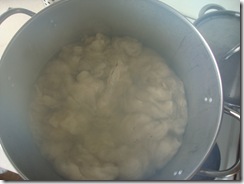 Oops think the camera has steamed up! Now in the huge pot with lots of vinegar just coming up to simmer. The fleece needs to be just covered with liquid but I’m afraid I don’t measure anything and just eyeball the amounts of distilled white vinegar. This fleece has been divided into two and probably about 750mls of white distilled vinegar added. Be warned the kitchen (and house) will smell very vinegary for a while but it is needed to set the dye.
Oops think the camera has steamed up! Now in the huge pot with lots of vinegar just coming up to simmer. The fleece needs to be just covered with liquid but I’m afraid I don’t measure anything and just eyeball the amounts of distilled white vinegar. This fleece has been divided into two and probably about 750mls of white distilled vinegar added. Be warned the kitchen (and house) will smell very vinegary for a while but it is needed to set the dye.
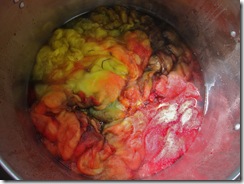 Again sorry about the pic, you can’t see it but the fleece is starting to gently bubble – just before that I splodged (technical term) food grade acid dye in a variety of colours – cooked until the surrounding water was clear. My house is sort of off the grid as we have a septic tank which has lots of little beasties doing what they do best in it and woe betide anyone who puts any nasty chemicals in. When the dye is exhausted (phew by this time I know I am) I turn the whole fleece over with tongs or masher which I keep just for these occasions and check for any white bits. These in themselves are not a problem and if left to be spun in when dry would just make the colours lighter and more pastel. If there are lots of white bits I just chuck in more vinegar and more dye and leave for another 15 to 20 mins or so. Much of this technique was inspired by Ashley Martineau of Neauveau Fiber Art who is a very talented fibre female and one whom I admire.
Again sorry about the pic, you can’t see it but the fleece is starting to gently bubble – just before that I splodged (technical term) food grade acid dye in a variety of colours – cooked until the surrounding water was clear. My house is sort of off the grid as we have a septic tank which has lots of little beasties doing what they do best in it and woe betide anyone who puts any nasty chemicals in. When the dye is exhausted (phew by this time I know I am) I turn the whole fleece over with tongs or masher which I keep just for these occasions and check for any white bits. These in themselves are not a problem and if left to be spun in when dry would just make the colours lighter and more pastel. If there are lots of white bits I just chuck in more vinegar and more dye and leave for another 15 to 20 mins or so. Much of this technique was inspired by Ashley Martineau of Neauveau Fiber Art who is a very talented fibre female and one whom I admire.
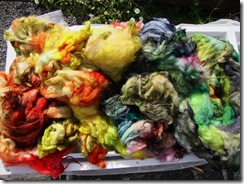 This is one fleece now drying outside in the sun, but two batches of dyebath. This means I split the wet fleece into two batches but they went in after one another. This really saves on water and heating etc. So once the dye has exhausted remove the fleece – I just pull it out with the masher into the sink to drain. The waiting fleece goes into the remaining liquid with a vinegar refresher and another set of colours. One batch was yellows, reds, orange and green and the second was purples, blues and pinks. It does take a while to dry here and as yet I haven’t been able to spin as I’m still waiting.
This is one fleece now drying outside in the sun, but two batches of dyebath. This means I split the wet fleece into two batches but they went in after one another. This really saves on water and heating etc. So once the dye has exhausted remove the fleece – I just pull it out with the masher into the sink to drain. The waiting fleece goes into the remaining liquid with a vinegar refresher and another set of colours. One batch was yellows, reds, orange and green and the second was purples, blues and pinks. It does take a while to dry here and as yet I haven’t been able to spin as I’m still waiting.
